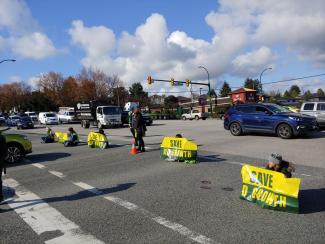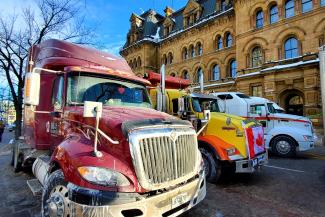Class Action against Old-Growth Highway Blockades Would Hit A Roadblock

Stepan Wood
Professor
Aug 17, 2022
A group calling itself Clear the Road recently threatened to launch a class action against Save Old Growth protesters who repeatedly blocked public highways, bridges and tunnels around BC in the first half of 2022. The blockades were intended to increase pressure on governments to ban old-growth logging and take urgent action on the climate emergency.
Whatever impact the blockades might have on government policy, they certainly impacted many highway users as they tried to go about their daily lives. The blockade opponents’ proposed class action would seek damages for the harm suffered by road users as a result of the blockades, including missed work, job interviews or medical appointments, not to mention lost business income due to shipping delays.
The group was inspired by a class action launched by Ottawa residents and businesses affected by the so-called Freedom Convoy’s occupation of the nation’s capital. In February, 2022, the plaintiffs in that class action got an interim injunction against the Freedom Convoy protesters.
From a legal perspective, however, the two situations were nothing alike.
People who share the protesters’ exasperation with the provincial government’s foot-dragging on the climate emergency and protection of old-growth forests can take some comfort from the knowledge that a class action against the Save Old Growth highway blockaders would have little chance of success.

Photo by Tim Brazier
First, what the “Clear the Road” group is complaining about, in legal terms, is a public nuisance. Interference with public highways has long been recognized as a public nuisance. But not just anyone can sue for public nuisance. In general, the government, via the Attorney General, has the exclusive right to sue for public nuisance, and has an absolute discretion whether or not to do so. Individuals can bring a private action for public nuisance only if they show “special damage”—direct and substantial damage that differs in kind, not just in degree, from that suffered by other members of the public.
Individuals and businesses affected by the Save Old Growth highway blockades would have a very hard time demonstrating special damage. They would have to show that they suffered a different kind of harm than that suffered by other road users affected by the blockades. In cases like this, the courts look for things like death, severe injury or permanent disability. Interference with business or employment, even severe, is seldom enough. For example, fishers whose businesses and livelihoods are devastated by industrial pollution of a public water body cannot sue for public nuisance, since they share the right to fish with the general public. Their loss, even though severe, is different in degree rather than kind.
The same is true of individuals affected by highway blockades. They share the right to use the highway with all members of the public. The fact that the blockades affect some people more severely than others is a difference of degree, not of kind. In this situation, it is up to the government to enforce the public’s right to travel on highways via criminal prosecution or a civil action for public nuisance.
Moreover, even if some individuals could show special damage, they would not be able to proceed by way of class action. A class action cannot be brought for public nuisance.

Photo by Kirk Slow on Unsplash.
By contrast, the Ottawa plaintiffs sued for private nuisance: unreasonable interference with their use and enjoyment of their own property—namely, their homes and places of business—caused by protesters blasting air horns up to 120 decibels, at all hours. They did not sue for public nuisance. The law is clear: unlike public nuisance, anyone suffering a private nuisance has standing to sue to remedy it.
The second major difference between the Save Old Growth blockades and the “Freedom Convoy” is that the Ottawa occupation was in place continuously for weeks, and was more aggressive than the vast majority of protests by Indigenous land defenders and environmentalists in Canadian history, including the Save Old Growth blockades.
It is crucial to note that assembling on public land, including highways, for the purpose of political expression is an ancient right that is enshrined in the Charter of Rights and Freedoms. Moreover, civil disobedience plays a key constructive role in advancing social justice and government accountability in democratic societies, as the well-known civil rights movements of the 20th century demonstrated.
The Save Old Growth protesters had a right to protest on public highways. By all accounts they were peaceful and non-violent. There is no indication that they threatened, assaulted or intimidated anyone. Quite the opposite: at least one protester was severely injured by an angry motorist. The blockades were also temporary, each lasting hours at most, not days or weeks.
The contrast with the so-called “Freedom Convoy” is stark. The occupation of downtown Ottawa was far from peaceful. It continued non-stop for weeks. There is a good argument that it exceeded the limits of lawful protest. It is doubtful that the highway blockades, however inconvenient or infuriating for some, crossed that line.
Balancing protesters’ civil rights against the rights of other highway users is a difficult task that governments and police face frequently. They have a legal responsibility to resolve it in a way that complies with the Charter. They do not necessarily do this well, but private parties do not have this responsibility and are in no position to engage in this crucial balancing exercise.
This is particularly true of the Clear the Road campaign, which is funded by Resource Works, an industry lobby group whose members profit from the continued extraction and consumption of timber, oil and gas. This is one reason why the task of balancing rights to use public spaces for protest or travel is entrusted to democratically accountable public authorities, not private parties with vested economic interests.
Another difference between the two cases is the nature of the harms allegedly suffered by the class members. For a class action to proceed, the common issues shared by all class members must outweigh the individual issues. There is a good argument that this is true of the Ottawa class action, where the only claim is for damage from noise and all class members were affected by the same noise sources in the same area over the same period.
By contrast, the “Clear the Road” claimants’ alleged injuries were disparate—from losing income to missing a doctor’s appointment or a child’s baseball game—and occurred at different times in different places. These harms would likely have to be proved individually for each member of the class.
Although the blockades died down in the summer of 2022, they could come back again at any time. In case that happens, it is useful to be ready with a response to disgruntled motorists’ threats of a class action.
In short, a private lawsuit against the Save Old Growth highway blockades would not only be without legal merit, it would divert attention from the necessity of urgent action to combat the intersecting crises of climate change and decimation of ancient forests.
- Centre for Law and the Environment

